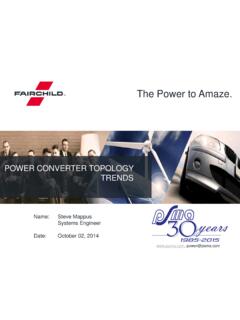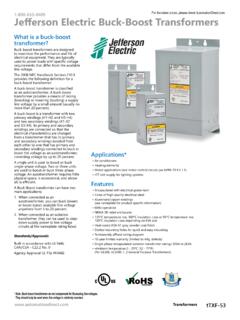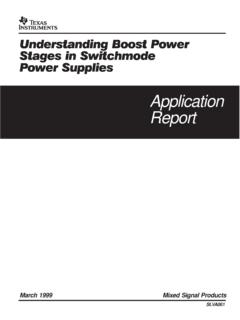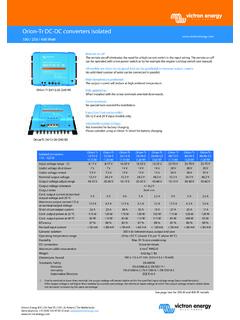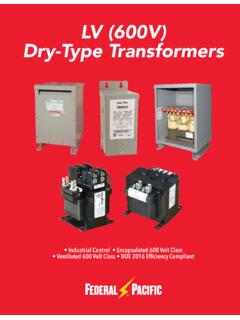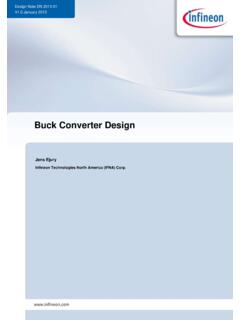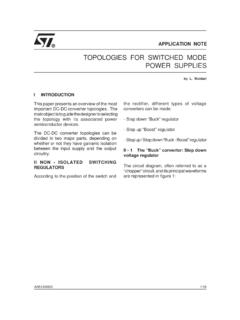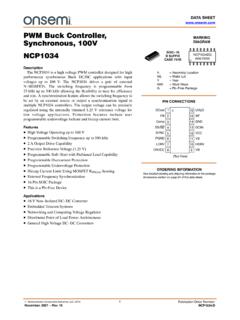Transcription of Full digitally controlled Power Supply design
1 Full digitally controlled Power Supply design Olivier Monnier TI Business Development Manager, C2000 DSP Controllers Agenda The Digital Vision: Why DSP? Digital world: FACTS and FIGURES. Digital AC/DC Rectifier challenges Software Strategy Implementation Next Steps Agenda The Digital Vision: Why DSP? Digital world: FACTS and FIGURES. Digital AC/DC Rectifier challenges Software Strategy Next Steps The Digital Vision Why Digital Approach for Power Supplies? Why DSP Controllers? Typical Analog based AC/DC rectifier V I V V I V I. Filter V I. PFC DC/DC. Bridge Output 8 4. 5 1. Inrush/ DC/DC Current/Load PFC. Hot-plug Converter Sharing Control Control Control Control Multi-mode Interface optional Power control circuit Monitor Supervisory MCU House (MCU ?) Keeping Circuits UART. Aux P/S To Host Digital approach with Single Device example for AC/DC Rectifier A.
2 1000W / 48 V. F2810 DSP based 2 Phase PFC-IL. Phase shifted ZVS-FB. 200 KHz PWM (DC/DC). 100 KHz PWM (PFC). Typical Control' System On A Chip buck Converter PWM. ( DAC' function). Comms CAN CPU. UART (DSP/uC/RISC). RX SPI + Control Loop TX IIC Memory ( PID/IIR). IIS (FLASH/ROM, FlexRay RAM). USB. EMAC. ADC V. Peripherals Quad Decoder Encoder Shown, Found On TI DSP. C2000 Family Of Devices Capture Hall Sensor Why DSP for Power Supplies? Controller PWM Power Elec. Analog or Digital ?? Sensor/s Analog Controller Digital Controller +. High bandwidth Insensitive to environment (temp, drift, ). High resolution High reliability Easy to understand / use S/w programmable / flexible solution relatively' low cost ?? Precise / predictable behaviour Advanced control possible (non-linear, multi- variable). Can perform multiple loops and other . functions Component drift and aging / Bandwidth limitations (sampling loop).
3 Unstable PWM frequency and resolution limits Component tolerances Numerical problems (quantisation, Hardwired / not flexible Limited to classical control theory only rounding, ). AD / DA boundary (resolution, speed, cost). CPU performance limitations ? Large parts count for complex System cost systems DSP Controllers value-Proposition Integration Flexibility Ease of differentiation System cost optimization Two Main Power Supply domains targeted Industrial Power supplies above 1kW. Multi-phase DC/DC loops requiring synchronization Agenda The Digital Vision: Why DSP? Digital world: FACTS and FIGURES. Digital AC/DC Rectifier challenges Software Strategy Next Steps Controller Considerations for Digital Power Supplies Ease of Use to r ! r f a c SW F ea Reliability CPU Performance PWM resolution Low Interrupt Latency Fast Sample Rate Numeric Considerations Cost Technical Support Fully Digital System Some Facts, Figures and Capabilities The Digital Domain.
4 Outputs 280x DSP. "DAC". buck / Boost Half bridge PWM Full bridge / PS. Multi phase IL. Clock speed (MIPs). Word size (dynamic range). "A D C ". MAC size (16x16 / 32x32). Inputs Large on-chip SRAMs ADC. C / C++ Current Voltage Temperature Resolution Continually Linearity / Accuracy Sampling rate (speed). Improving HV isolation specs ! Processor capability # Inst. vs Algorithm S/W algorithm clks Controller 26. (2 pole / 2. zero). Controller 36. (3 pole / 3. zero). # Instructions vs PWM. PFC current 30. PWM freq. PWM per. Processor MIPS command (KHz) (uS) 40 100 150. 50 800 2000 3000 PFC OVP 25. 100 400 1000 1500 BiQuad Filter 46. 200 200 500 750. ZVSFB PWM 14. 250 160 400 600. driver 300 133 333 500. 500 80 200 300 PFC2 PHIL PWM 26. 750 53 133 200 driver 1000 40 100 150. MIPS = Million Instruction Per Second Typical Power Stage Switching Frequencies Freq.
5 (KHz) Typ. Application Power stage 10 ~ 35 Motor Control 3 Phase Inverter 50 ~ 120 UPS Boost / buck / ?? 80 ~ 160 PFC + boost Single / Multi-phase Interleaved AC/DC Rectifier 120 ~ 240 DC/DC ( isolated ) H-bridge / Full-Bridge /. AC/DC Rectifier FB-ZVS. 200 ~ 1000 DC/DC (non-isol.) Single phase buck /. DPA-Enterprise Multi-phase Interleaved 1 ~ 4 MHz DC/DC (non-isol.) Single phase buck /. DPA / Bricks Multi-phase Interleaved Benefits of higher frequencies 1) Higher Power density 4) Faster transient response 2) Smaller magnetics 5) Smaller ripple amplitude 3) Lighter Power supplies Agenda The Digital Vision: Why DSP? Digital world: FACTS and FIGURES. Digital AC/DC Rectifier challenges Software Strategy Next Steps Digital approach with Single Device example for AC/DC Rectifier A. 1000W / 48 V. F2810 DSP based 2 Phase PFC-IL. Phase shifted ZVS-FB. 200 KHz PWM (DC/DC).
6 100 KHz PWM (PFC). Digital Control design Steps Choose the topology for each Power stage. Choose the location for the microprocessor: primary side or secondary side. Define the gate drive circuits. Define the ADC signal conditioning circuits. Choose the configuration of the timing hardware that implements the PWM signals, ADC strobe and interrupt service routine (ISR). timing. Architect the firmware: time critical interrupts versus background Implement the SW. Closing the loop digitally offers several advantages when bringing up a system for debug. Each stage can be enabled separately. Loops can easily be run open-loop, usually by commenting out a line of code. Compensation parameters are quickly changed with a few keystrokes. Sophisticated diagnostics are possible, such as a circular buffers or complex event triggers. Digital Control design Steps Choose the topology for each Power stage.
7 Choose the location for the microprocessor: primary side or secondary side. Define the gate drive circuits. Define the ADC signal conditioning circuits. Choose the configuration of the timing hardware that implements the PWM signals, ADC strobe and interrupt service routine (ISR). timing. Architect the firmware: time critical interrupts versus background Implement the SW. Closing the loop digitally offers several advantages when bringing up a system for debug. Each stage can be enabled separately. Loops can easily be run open-loop, usually by commenting out a line of code. Compensation parameters are quickly changed with a few keystrokes. Sophisticated diagnostics are possible, such as a circular buffers or complex event triggers. Agenda The Digital Vision: Why DSP? Digital world: FACTS and FIGURES. Digital AC/DC Rectifier challenges Software Strategy Next Steps Software Modularity, re-use efficiency.
8 Software - is key in Digital Power ! Software playing a more significant role in AC/DC rectifier applications Analog controlled Power stage Traditionally S/W role: Supervisory + Monitoring + Comms 8 / 16 bit MCU based digitally controlled Power stage Digital Power S/W role: Supervisory + Monitoring + Comms + Closed loop control 16 / 32 bit DSP based Opposing approaches to Software development Wait for release of 1. Conservative approach appropriate device Strictly High level language ( C / C++) 200-300 MIP. Conventional function calling / parameter passing device @ $5-$10. Real-time OS as needed 2. getting your performance entitlement Push perf. envelope Combination C / ASM on existing devices flat in-line coding 100-150 MIP. non-conventional function calling / parameter passing devices @ $5-$10. simple single ISR structure Defining GOOD Software Modularity blocks with well defined inputs / outputs ( cause and effect ).
9 Multiple instantiation of same module or function De-lineation (separation) between code and device peripherals or target h/w use of peripheral (h/w) drivers Re-useable / Re-targetable (maximize return on investment). Efficient & high performance code execution in minimal time Easy to use / read / interpret / debug / modify .. friendly! 1 of 2. Exploring Modularity Function or object with well defined boundaries Clear relationship between inputs / outputs ( cause / effect ). Used multiple times, while maintaining a single source Multiple Instantiation . Re-entrant ( supports nesting of itself ). trust for now, explore / understand later . Module example 1. f(x) = Sin (x). Single In / Single out Non-configurable No History Multiple Instantiation Out = Sin (In). 2 of 2. Exploring Modularity Module example 2. f(x) = mx + b Single In / Single out Configurable m, b, Constant ?
10 Or Variable ? No History Out = + b Multiple Instantiation Module example 3. Single In / Single out Non-Configurable f(x) = ( xn + xn-1+ xn-2 + xn-3 ) / 4. History Multiple Instantiation BoxCarAvg In Out X(n). X(n-1). X(n-2). X(n-3). Module Types Application Indep. / Application Config. / Application Config. /. Peripheral Indep. Peripheral Indep. Peripheral Depend. ( Peripheral Driver ). CNTL. 2P2Z. Ref Out Fdbk SinGen T1. Freq Out Gain Offset 1 of 2. Peripheral Drivers Depends on: PWM frequency System clock frequency CPU dependency only: Math / algorithms Depends on: Per-Unit math (0-100%) # ADC bits (10 / 12 ?). Independent of Hardware Unipolar, Bipolar ? Offset ? Q-Math Representation Fixed point format S I . F (Sign / Integer . Fraction). Q15 FFFF FFFF FFFF - 1 < N < + . Q14 FFFF FFFF FFFF - 2 < N < + . Q13 FFFF FFFF FFFF - 4 < N < + . Q12 SIII.










